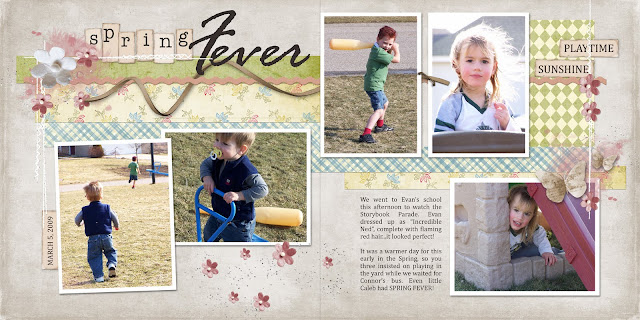There's been
a lot of discussion lately on the forum at
Scrapbook News and Review Magazine about using sketches. Do you like them...are they helpful...is it "cheating"...do you have to list them in the credits...
I, for one, love me some sketches. I find them to be wonderful springboards for my creativity, whether my interpretation of them is very literal or more abstract. When I don't have to spend so much time adjusting the placement of everything on the page (and sometimes starting over completely), the energy and stamina I have for the details are much greater. Plus, sketches keep me from sliding into same-ness; because left to my own devices, I tend to place things in very similar geography from one layout to the next.
For me, finding the perfect sketch that showcases the photos I want to use is just like finding the perfect embellishment or piece of paper. And no one ever accuses you of "cheating" if you don't make your own paper or use a store-bought flower instead of something you did yourself! Just like following a recipe or an architectural blueprint, a scrapbooking sketch is meant to take the guesswork out of the structural aspect of the process. And, just like a recipe or blueprint, they can be adapted as the circumstances change. Double it. Halve it. Stretch it out and turn it on its side. Replace areas intended for pictures with scraps of paper. Or go the other direction and add more photos to something that only shows one.
The key here is this...if you see a sketch and you like what it has to say, use it! The simple act of selecting your own papers and elements will make it yours. But, in the end, do be sure to credit the sketch artist. Many artists require credit in their Terms of Use, and even if they don't, it only seems polite to pass along their information for those who may see your page and like the layout as well!
Here are a few pages I've done, and the sketches that inspired them. First, a couple that stuck pretty closely to the original sketch:

Sketch by Carey Bridges for Scrapbook News and Review Magazine
I made three very minor changes to the sketch in designing this page. 1. I slightly tilted one picture on the left page to bring more focus to it (it's my
fav on the page!). 2. I divided the area on the right page that was intended for one large picture into two. This was based solely on how many pictures I wanted to include in the layout. 3. I carried the background strips of paper all the way across the page divide, rather than stopping a half inch or so before it cuts off. Again, this was totally a matter of taste, and I prefer that extra bit of cohesion between the pages. I used a
similar treatment in the example below.
Although this layout is based on the same sketch, by simply choosing different elements and colors, it takes on an entirely different personality than the previous example. Again, I made a few small adjustments to better suit my purposes in these pages. 1. I used a third picture on the left side instead of embellishments. 2. I broke up the same large picture on the right, but this time into three spots to accommodate a series of similar shots. 3. I replaced the small piece of patterned paper on the right page (represented in polka-dots on the sketch) with a larger, mat-like sheet of yellow paper. This brought extra color into a design that was starting to look too dark, and provided a much better backdrop for the journaling.
And, now, for an idea of how to use a sketch as inspiration, rather than a precise measurement:

Sketch by Charlene Walberg for Scrapbook News and Review Magazine
A couple aspects of this sketch are readily identifiable in my page: namely, the placement of the photo and the horizontal piece of paper behind it. After that, I took some artistic license. I didn't want a large section of the wooden background to be covered, so I created the effect of paint strokes to more subtly create pattern and texture in its place. I used a single spot instead of multiple tags, and then decided on the large door hinge as a horizontal element to replace the title treatment in the sketch. So, while the result is not an element-for-element copy of the sketch, each piece is represented in the page and adapted to fit my needs.
So, that's the genius of using a sketch: complete personalization without the stress of determining structure. I think it's a sure-fire way to hone your creative instinct.














 These sketchy tulips are by Hero Arts Digital and available at
These sketchy tulips are by Hero Arts Digital and available at